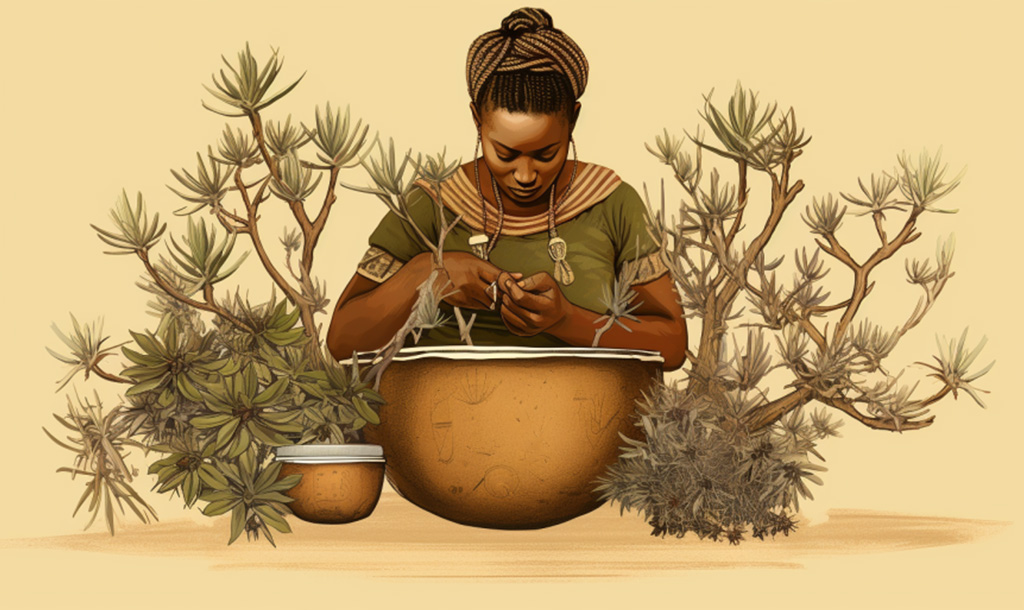In the vast, diverse continent of Africa, secrets of the land whisper tales of tradition and healing. And right from the heart of South Africa emerges one such tale, that of Buchu. This indigenous plant, revered for centuries by the Khoisan people, is more than just a shrub. For many who believe in its healing potential, it is uzima (life in Swahili).
So, what makes Buchu this wondrous plant?
Historical Roots
The tale of Buchu, deeply rooted in South Africa’s landscape, is intertwined with the narratives of its indigenous peoples, notably the Khoisan. These hunter-gatherers, believed to be among the region’s oldest inhabitants, have thrived for millennia amidst its mountains, valleys, and coasts. Their connection to the land is profound, and Buchu is a testament to this bond.
As legends have it, the Khoisan discovered the healing potential of Buchu long before the written records began. They revered the plant, utilizing its leaves extensively in their day-to-day lives. Whether they suffered from ailments of the stomach, infections, or required an energy boost, Buchu was their go-to dawa (medicine in Swahili). Brewed into tea or applied as a poultice, the plant’s versatility was unmatched. In their eyes, Buchu was more than a remedy; it was a bridge to their ancestors, an essential component of sacred rituals and ceremonies.
Over time, as explorers and settlers stepped foot in South Africa, they became privy to the local traditions, and soon, the secrets of Buchu started to spread. Dutch settlers, in particular, took a keen interest in this plant, incorporating it into their medical practices. By the 18th century, Buchu’s reputation had transcended South African borders, with European merchants and traders eager to get their hands on this “miracle herb.”
Yet, as with many indigenous practices and traditions, Buchu’s significance is not merely in its functionality. The plant stands as a symbol of resilience, memory, and identity for the Khoisan. It tells tales of ancient wisdom when humans and nature coexist harmoniously. The echo of asili yako ni muhimu (your origin is important) reminds us that in the story of Buchu, we are not just witnessing the chronicle of a plant but the heritage of people and their enduring bond with the land.
Buchu in Wellness
Modern times have seen the world inch closer to holistic health approaches, and Buchu stands tall in its rightful place. It’s loaded with bioflavonoids, compounds that boast impressive anti-inflammatory benefits. With the world seeking natural solutions, many people are turning to Buchu to relieve ailments like arthritis, infections, and even digestive issues.
Beyond the internal benefits, Buchu is becoming a star ingredient in the wellness industry. A glance at Cape Town and Johannesburg wellness retreats reveals a surge in Buchu-infused therapies. Its prominence is undeniable, from Buchu-infused saunas to luludi (flower in Swahili) treatments featuring the plant.
Buchu and Skincare
Skincare is another frontier where Buchu is making significant inroads. This plant’s antiseptic and anti-inflammatory properties make it a perfect ally for combating acne, reducing redness, and soothing the skin. And if that wasn’t enough, the oil distilled from Buchu leaves is rich in vitamins, providing an excellent source of nourishment for the skin.
While the Western world is just waking up to the marvels of Buchu, African communities have long since known its worth. In Swahili, there’s a saying, “asili yako ni muhimu” (your origin is important). It speaks to the importance of recognizing the roots and valuing the age-old wisdom that accompanies traditions.
Looking Ahead
With global wellness trends and an emphasis on natural care, the future for Buchu looks bright. Its journey from the sacred rituals of the Khoisan to the bustling wellness spas of significant cities is nothing short of remarkable. But this journey is just the beginning. As the world becomes more connected, it is only a matter of time before Buchu takes its place in every home, not just as a marvel from South Africa but as a symbol of uzima and well-being.
In conclusion, while the wonders of Buchu are vast and impressive, it’s crucial to remember the roots from which it emerged. It is not just a plant or a product; it’s a story, a hadith (a tale in Swahili) of tradition, healing, and hope. And in this rapidly changing world, maybe, just maybe, the tales of Buchu and its magic are precisely what we need.


